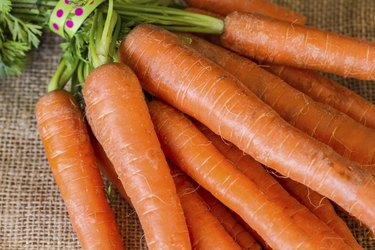
Carotenemia is the presence of high levels of beta carotene in the blood. Carotenemia is also sometimes called carotenodermia. People who have this medical condition may show an orange-yellow discoloration of the skin, especially on the palms of the hands and soles of the feet, according to the UCLA Department of Medicine. Carotenemia can be the result of eating large quantities of foods that are orange, yellow or green in color.
Carrots
Video of the Day
Carrots are a food to avoid in the case of carotenemia. The orange color of the vegetable is made from beta carotene, a nutrient that is transformed into vitamin A in the human body. Vitamin A helps make normal skin color, but too much can give skin a yellowy hue. One cup of carrots contains more than 600 percent of the recommended daily allowance for vitamin A, according to WHFoods.
Video of the Day
Sweet Potatoes
The yellow or orange color of sweet potatoes can also contribute to carotenemia and should be avoided if directed by your doctor. Sweet potatoes and carrots tend to be among the first vegetables fed to babies, which may lead to a yellow tinge to the skin. A 2004 issue of "Pediatric Dermatology" explains that some parents may think their infants have jaundice, but carotenemia is a different condition and may be common in young children.
Squash
Winter squash that is orange or yellow in color may cause carotenemia. Squash may be restricted if blood levels of carotene indicate levels are already too high. A single cup of squash provides more than 7,000 international units of vitamin A, or 145 percent of a person's recommended daily serving.
Orange-Colored Fruits
UCLA's Department of Medicine indicates that orange-colored fruits such as cantaloupe and oranges are also a food source for carotene. Limiting these items may help abnormal skin coloring recede.
Green Beans
Green beans contain carotene and can lead to carotenemia if eaten in large quantities, according to the November 2004 issue of "Pediatrics Dermatology." The green color of the vegetables may confuse people, but the darker shade of the vegetable just hides the carotene within.
Leafy Greens
Leafy green vegetables contain high levels of carotene and vitamin A, according to WHFoods.org. Spinach is especially concentrated in vitamin A, with 1 cup containing 377 percent of the recommended serving. Kale, broccoli, collard greens and romaine lettuce should also be limited if carotenemia is a problem.